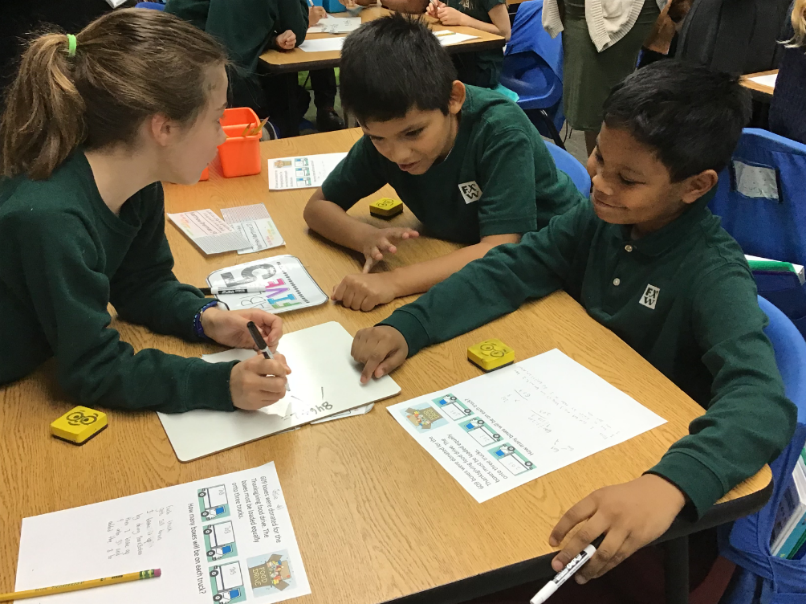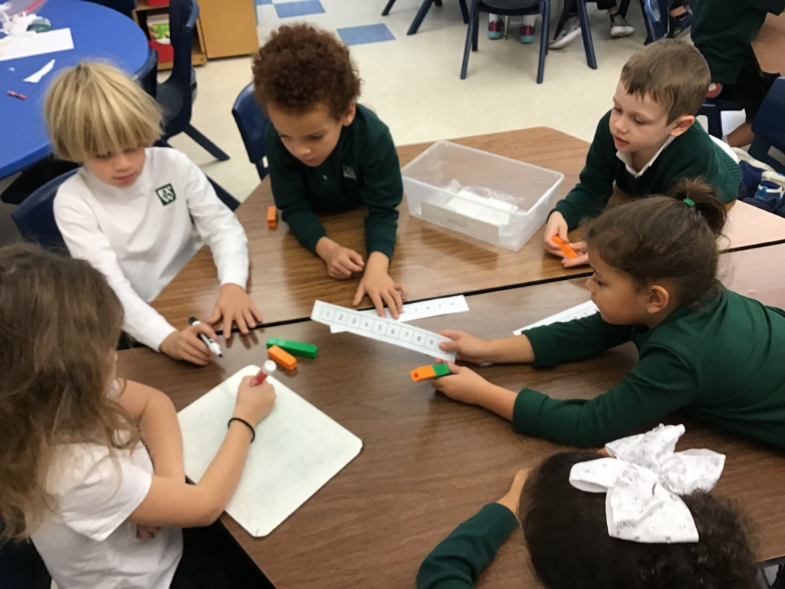Reflection from Amy Bilek, K-8 Math Instructional Coach
Math Revolutionized
Think about how math class started when you went to school. Did a teacher stand at the front of the room, using a chalk board or overhead projector to explain a math procedure or concept? Did you take notes and follow the directions step by step? Then, did you try some practice problems together, before working on your own? If this sounds familiar, you may be wondering why math classes seem to be shifting to this new approach of teaching through an anchor task. What exactly does it mean to teach through a task and what is the purpose behind it?
What is an Anchor Task?

An anchor task is a problem given to students at the beginning of a math lesson that provides an opportunity to activate prior knowledge, requires students to collaborate and ask questions of each other, and promotes an environment for students to productively struggle and persevere in problem solving.
Jo Boaler might talk about these as “low floor, high ceiling tasks.” Low floor because they are accessible to the weakest students in the class, and high ceiling because the most advanced learners continue to receive challenges in that task.
In the Grade 2 example above, a less-confident math student has an access point because he can start by counting the cookies one by one, or possibly two by two. A more advanced learner can begin to explore the concept of multiplication and possibly explore its relationship to repeated addition.
Marian Small may call tasks like these “open questions” because one question can meet the needs of many learners as the question is not overly tight and so benefits a broader range of students.
Here is Dr. Yeap Ban Har, Singapore math expert in curriculum and instruction and author of think! Mathematics explaining more about anchor tasks.
Why Start a Class with an Anchor Task?

A traditional math class, similar to what you may have experienced growing up, generally began with the teacher modeling a procedure, students taking notes, and maybe trying some problems together. Then, students would work to practice that procedure independently. Why change that?
When you build a classroom culture in which you start each class with an anchor task, the students take ownership of their learning. Students must work to make sense of mathematics by making connections to what they know and discussing with their peers. The solutions then come from the students in the room, rather than the teacher explaining how the math works. Teachers in a task-based math classroom are not seen as the dispensers of knowledge, but rather as facilitators helping students move through the learning progression with the students actively engaging in thinking and sense-making.
This new structure for a math classroom, in which students engage in exploring a task before any direct instruction from the teacher, is based on research and educational best-practice. The use of an anchor task engaged students in the active learning process. Students learn best when they are active rather than passive learners. Students must be engaged in exploring, thinking, practicing, and using knowledge, rather than listening to verbal concepts (Sun & Pyzdrowski, 2009; Curtain-Phillips, 2001; Schreiner, n.d.).
Anchor task exploration is made richer because students are encouraged to collaborate with their peers and share their discoveries. Mathematical discourse in cooperative groups provides students with opportunities to exchange ideas, ask questions freely, verbalize their thoughts, justify their answers, and debate processes. (Geist, 2010; Hellum-Alexander, 2010; Woodard, 2004; Haralson, 2002; Curtain-Phillips, 2001). The aim of mathematics education is to create autonomous learners who persevere in problem solving. The purpose of mathematics education is not to impart knowledge, but instead to facilitate a student’s thinking and problem-solving skills which can then be transferred to a range of situations (Bruner, 1961).
Finally, in moving from a direct instruction classroom to one in which students must explore and make connections to prior knowledge, instruction moves beyond instrumental understanding (the ability to execute mathematical rules and procedures) and focuses on relational understanding (knowing both what to do and why). Students are able to build schema and find new ways of “getting there” without outside help demonstrating great flexibility. (Skemp, 1976).
Conclusion

When you work to build a classroom culture and routine in which students know that they are responsible for coming up with and sharing the new math learning, students come to see themselves as mathematicians and problem solvers. Teaching through a task not only allows you to engage in the grade-level content but also to engage students in the math practices, such as perseverance, sense-making, reasoning and pattern seeking, choice of tool, and mathematical discourse. When you teach through task, students are not only learning the math content, they are learning to think and becoming mathematicians.
Amy has taught at FXW since 2014. She is also invested as a multi-year SEED participant and believes in the value of the work of the Equity and Justice Forum’s Cultural Competency in Curriculum Committee. To learn more about how educators are humanizing math, read Learning for Justice’s (formerly Teaching Tolerance) Mathematics in Context: The Pedagogy of Liberation.
—Amy Bilek, K-8 Math Instructional Coach

